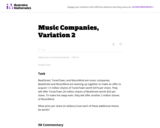
This real world word problem requires multiple steps.
- Subject:
- Mathematics
- Material Type:
- Activity/Lab
- Provider:
- Illustrative Mathematics
- Provider Set:
- Illustrative Mathematics
- Author:
- Illustrative Mathematics
- Date Added:
- 05/01/2012

This real world word problem requires multiple steps.
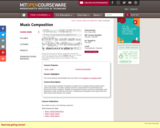
Directed composition of larger forms of original writing involving voices and/or instruments. Includes a weekly seminar in composition for the presentation and discussion of student work in progress. Students are expected to produce at least one substantive work, performed in public, by the end of the term. Contemporary compositions and major works from twentieth-century music literature are studied. Meets with graduate subject 21M.505, but assignments vary.
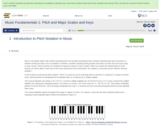
This collection is the first of five dealing with the rudiments of music.
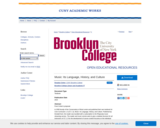
Welcome to Music 1300, Music: Its Language History, and Culture. The course has a number of interrelated objectives:
1. To introduce you to works representative of a variety of music traditions.These include the repertoires of Western Europe from the Middle Agesthrough the present; of the United States, including art music, jazz, folk, rock, musical theater; and from at least two non-Western world areas (Africa, Asia, Latin America, the Caribbean, the Middle East, Indian subcontinent).
2. To enable you to speak and write about the features of the music you study,employing vocabulary and concepts of melody, rhythm, harmony, texture, timbre,and form used by musicians.
3. To explore with you the historic, social, and cultural contexts and the role of class, ethnicity, and gender in the creation and performance of music,including practices of improvisation and the implications of oral andnotated transmission.
4. To acquaint you with the sources of musical sounds—instruments and voices fromdifferent cultures, found sounds, electronically generated sounds; basic principlesthat determine pitch and timbre.
5. To examine the influence of technology, mass media, globalization, and transnationalcurrents on the music of today.
The chapters in this reader contain definitions and explanations of musical terms and concepts,short essays on subjects related to music as a creative performing art, biographical sketchesof major figures in music, and historical and cultural background information on music fromdifferent periods and places.
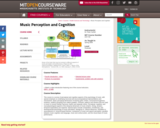
This course is a survey of perceptual and cognitive aspects of the psychology of music, with special emphasis on underlying neuronal and neurocomputational representations and mechanisms. Basic perceptual dimensions of hearing (pitch, timbre, consonance/roughness, loudness, auditory grouping) form salient qualities, contrasts, patterns and streams that are used in music to convey melody, harmony, rhythm and separate voices. Perceptual, cognitive, and neurophysiological aspects of the temporal dimension of music (rhythm, timing, duration, temporal expectation) are explored. Special topics include comparative, evolutionary, and developmental psychology of music perception, biological vs. cultural influences, Gestaltist vs. associationist vs. schema-based theories, comparison of music and speech perception, parallels between music cognition and language, music and cortical action, and the neural basis of music performance.
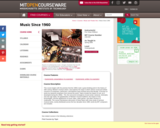
Begins with the premise that the 1960s mark a great dividing point in the history of twentieth-century Western musical culture, and explores the ways in which various social and artistic concerns of composers, performers, and listeners have evolved since that decade. Focuses on works by classical composers from around the world. Topics to be explored include: the impact of rock, as it developed during the 1960s-70s; the concurrent emergence of post-serial, neo-tonal, Minimalist, and New Age styles; the globalization of Western musical traditions; the impact of new technologies; and the significance of music video, video games, and other versions of (digital) multimedia. Interweaves discussion of these topics with close study of seminal musical works, evenly distributed across the four decades since 1960. Works by MIT composers included.
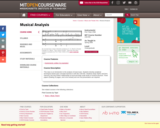
An introduction to the analysis of tonal music. Students develop analytical techniques based upon concepts learned in Harmony and Counterpoint I and II. Students study harmony, counterpoint, melodic line and motivic relationships at local and large scale levels of musical structure. Three 7-page papers, one revised paper, and one oral presentation required.
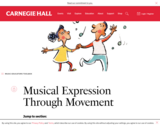
Students demonstrate expressive qualities of music through movement.
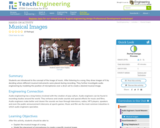
Students are introduced to the concept of the image of music. After listening to a song, they draw images of it by deciding where different musical instruments were placed during recording. They further investigate audio engineering by modeling the position of microphones over a drum set to create a desired musical image.
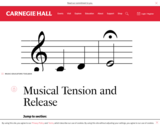
Students learn to identify tension and release within a piece of music.

In this group task students collect data and analyze from the class to answer the question "is there an association between whether a student plays a sport and whether he or she plays a musical instrument? "
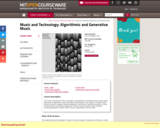
This course examines the history, techniques, and aesthetics of mechanical and computer-aided approaches to algorithmic music composition and generative music systems. Through creative hands-on projects, readings, listening assignments, and lectures, students will explore a variety of historical and contemporary approaches. Diverse tools and systems will be employed, including applications in Python, MIDI, Csound, SuperCollider, and Pure Data.
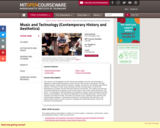
This course is an investigation into the history and aesthetics of music and technology as deployed in experimental and popular musics from the 19th century to the present. Through original research, creative hands-on projects, readings, and lectures, the following topics will be explored. The history of radio, audio recording, and the recording studio, as well as the development of musique concr?te and early electronic instruments. The creation and extension of musical interfaces by composers such as Harry Partch, John Cage, Conlon Nancarrow, and others. The exploration of electromagnetic technologies in pickups, and the development of dub, hip-hop, and turntablism. The history and application of the analog synthesizer, from the Moog modular to the Roland TR-808. The history of computer music, including music synthesis and representation languages. Contemporary practices in circuit bending, live electronics, and electro-acoustic music, as well as issues in copyright and intellectual property, will also be examined. No prerequisites.
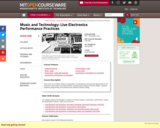
This course is a creative, hands-on exploration of contemporary and historical approaches to live electronics performance and improvisation, including basic analog instrument design, computer synthesis programming, and hardware and software interface design.

Children are inherently musical. They respond to music and learn through music. Music expresses children’s identity and heritage, teaches them to belong to a culture, and develops their cognitive well-being and inner self worth. As professional instructors, childcare workers, or students looking forward to a career working with children, we should continuously search for ways to tap into children’s natural reservoir of enthusiasm for singing, moving and experimenting with instruments. But how, you might ask? What music is appropriate for the children I’m working with? How can music help inspire a well-rounded child? How do I reach and teach children musically? Most importantly perhaps, how can I incorporate music into a curriculum that marginalizes the arts?
This book explores a holistic, artistic, and integrated approach to understanding the developmental connections between music and children. This book guides professionals to work through music, harnessing the processes that underlie music learning, and outlining developmentally appropriate methods to understand the role of music in children’s lives through play, games, creativity, and movement. Additionally, the book explores ways of applying music-making to benefit the whole child, i.e., socially, emotionally, physically, cognitively, and linguistically.

Students' understanding of how robotic touch sensors work is reinforced through a hands-on design challenge involving LEGO MINDSTORMS(TM) NXT intelligent bricks, motors and touch sensors. They learn programming skills and logic design in parallel as they program robot computers to play sounds and rotate a wheel when a touch sensor is pressed, and then produce different responses if a different touch sensor is activated. Students see first-hand how robots can take input from sensors and use it to make decisions to move as programmed, including simultaneously moving a motor and playing music. A PowerPoint® presentation and pre/post quizzes are provided.
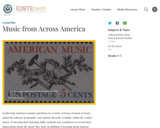
Students examine and listen to a variety of forms of music to learn about the cultural, geographic, and stylistic diversity available within the United States.
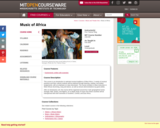
Focuses on musical traditions of West Africa. A variety of musical practices and their cultural contexts are explored through listening, reading and written assignments with an emphasis on class discussion. Subject includes in-class instruction in Senegalese drumming, song and dance, as well as live lecture-demonstrations by guest performers from throughout West Africa. This course is an introduction to selected musical traditions of West Africa. A variety of musical practices and their cultural contexts will be explored through listening, reading, and written assignments, with an emphasis on class discussion. The course includes in-class instruction in West African drumming, song and dance, as well as lecture-demonstrations by guest artists. After an introductory unit, the course will be organized around four main geographical areas: Senegal, Mali, Ghana, and Nigeria. An in-depth study of music from these countries will be interspersed with brief overviews of Southern, Central, and East Africa.
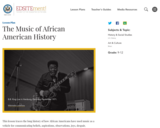
This lesson traces the long history of how African Americans have used music as a vehicle for communicating beliefs, aspirations, observations, joys, despair, resistance, and more across U.S. history.
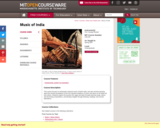
Focuses on Hindustani classical music of North India, and also involves learning about the ancient foundations of the rich classical traditions of music and dance of all Indian art and culture. Practice of the ragas and talas through the learning of songs, dance, and drumming compositions. Develops insights through listening, readings, and concert attendance.